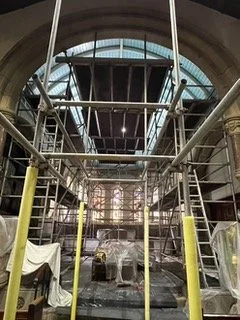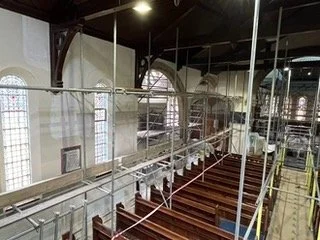Our History
St Saviour's church was created as a chapelry in 1836 from the existing parish of St Leonard, Walton-le-Dale, although it was not until 1884 that it officially achieved the status as a parish in its own right. Initially both churches were part of the Diocese of Chester.
The new church building was mainly funded by public subscription, the land having been donated by Robert Townley Parker of Cuerden Hall. It was designed in a Romanesque style by the young Lancaster architect Edmund Sharpe, following his architectural study tour of Europe. It was one of his first commissions and one of several early churches he designed in this style.
Externally the new extensions were built in matching Whittle stone, but internally polished granite columns were introduced to support the transept arches, with other features such as the arches themselves dressed with finer Longridge sandstone.
However, the records tell us that there was still considerable prudence exercised in the enlarging of the building, with the original chancel 'rose' window salvaged and reused in the new south transept, and a matching one made for the opposite transept. Similarly the lancet windows of the old chancel were reused in the new vestry and organ chamber, the best nave windows were inserted into in the north wall to replace the old doorway, and much of the dressed stone was also salvaged and reused.
St Saviour's church has little pictorial stained glass, the majority of the narrow, round arched single lancet windows having a diaper pattern of small plain leaded lights, with some ornamentation in the leadwork just below the arch, such as the formation of a Star of David.
Of the pictorial windows, a group of three are to be found in the chancel. These were added in 1891, not long after the construction of the chancel, in memory of local mill owner GB Dewhurst, and were reputed to have been donated by his former employees. They depict Isaiah, Jeremiah and David.
By the 1920s we are told that the church building was beginning to show its age, and was particularly in need of redecoration and some improved lighting. Consequently, in 1928 the church had electric lighting installed for the first time, with redecoration of the interior completed the following year, and new flooring laid to the aisles. However, apart from this work, and some necessary but general repairs, few alterations were made during the period from the 1890s to the twenty-first century. Arguably the more significant changes during this period concerned the setting of the church building. There was an expansion of the churchyard in the 1920s (see the Churchyard section), but prime amongst the changes around the building was the creation in 1958 of the Preston Bypass, now better known as the M6 motorway. This radical piece of engineering effectively separated the church itself from the eastern side of the parish. Later, in 1986, the Bamber Bridge by-pass was also built close by, as the A6 trunk road was diverted around the south of the church, leaving the old Church Road downgraded and as a cul-de-sac.
Improvements
Damage and Repairs
Just as work was about to start on the exciting narthex improvements, our roof incurred significant damage at the hands of thieves as they smashed the slates to rip out the lead. This was a devastating blow to all who had raised and committed money to the narthex project, but the roof had to be repaired, and with the cost of the options, it was agreed that repair was not a viable option. With help from English Heritage, enough money was raised to re-slate the whole church, improve the roof insulation, and use terne-coated stainless steel for the flashings instead of lead. The roof was also equipped with the latest alarm system to reduce the risk of future damage.
Unfortunately, despite all attempts to protect the building, a considerable amount of rainwater entered during the period between the lead being stolen and the final re-roofing. The water damaged the plaster of the walls and also found its way into parts of the pipe organ.
It was even more distressing to discover later that the water had caused an outbreak of dry rot in the roof timbers. A further period of fund-raising followed and after much effort eventually allowed the parish to eradicate the rot and treat the timber and masonry in and around the affected areas.
Parts of the interior were cocooned in scaffolding and plastic sheets for two years.
However, a significant part of the subsequent repair work entailed making some important structural repairs to the roof trusses and quite extensive re-plastering of the affected walls.
During this work, the opportunity was also taken to make repairs to other areas that already had defective plasterwork. One significant consequence of the roof lead theft was the damage done to the pipe organ, which was already in need of a major overhaul. Expert opinion confirmed that it was beyond economic repair, eventually leading to the purchase of a high-quality electronic organ as a replacement.
This instrument has been temporarily housed in the transept, but work has now started to move it into the chancel. A radical reordering of the chancel is being undertaken, with the old pipe organ and choir pews removed, giving us a larger and more flexible space for a variety of worship options.
The church was listed Grade II in 1984, as was the former St Saviour's School across the road, which was begun in 1840.
The Churchyard
Recent years have brought significant changes to the building, which prior to 2010 had seen few alterations. First, the parish embarked on the creation of a new narthex to provide a much needed meeting space at the back of church, with its associated tea kitchen and accessible toilet. Some of the rear pews were removed, making space to relocate a Victorian timber screen which, linked with a modern glass screen, now separates the new space for the remaining nave. The Suite, as it has become known, was opened and blessed by Bishop in 2011.
While this disruptive work was going on, the church seized the opportunity to completely renew the heating system, with new radiators, pipework, and modern, efficient condensing boilers.
The church has two burial grounds, one located on the north side of Church Road, and the main one which lies to the north-west and south-east of the building.
Originally the boundary on the east side of the church was much closer to the building, but additional land was consecrated in the early twentieth century to increase the overall size of the burial ground, and Coronation Walk was created to commemorate the coronation of George V in June 1911. The walk was created by volunteer labour, linking the church and the lychgate.
The churchyard is open to all and has become a valued green space, enjoyed by many, and a rich source of local flora and fauna.
The original churchyard was a small rectangular space surrounding the original, smaller church, and as a result, the oldest graves may be found here. Among them is the grave of Reverend William Wignall, who was buried here in 1867 after 30 years as the church's first incumbent.
However, as early as 1879, plans were made to increase the size of the churchyard, which had become crowded and was eventually closed four years later. The lack of burial space was met by the creation of a new burial ground, not next to the church but on the opposite side of Church Road, on land that was part of the glebe land of the then incumbent Reverend James Taylor.
A major expansion of the original churchyard next to the church occurred in 1911, with the creation of Coronation Walk. This was formed on land given by Mr Tatton of Cuerden Hall, and built by large numbers of men of the parish, and was to commemorate the Coronation of George V in June 1911. A further gift of land by Mr Tatton in 1915 provided burial space to the west of Coronation Walk, and the whole extension was consecrated in June 1915 by the Bishop of Manchester.
As in many churches, the churchyard's principal feature is the lynch gate, located at the northwestern end of Coronation Walk. Installed to commemorate the church's centenary in 1937, it was designed by ACM Lillie and funded by the parish. Inscriptions bear the names of the incumbent at the time, Reverend WF Cook, and the first, Reverend William Wignall.
Other, more modest expansions of the churchyard have occurred in recent years. In 1946, land was added to the south-east of the church, with a further piece added in 1985.
Interestingly, first took in the former coach house and stable, which had been built by Robert Townley Parker in the previous century to serve his family's attendance at church. From here the Townley Parker family would have entered the church by gateway and the southern door into the transept, and to their private pews. Unfortunately the structure was demolished in 1975 and there is little trace to be seen today.
The second piece was bought from the Central Lancashire Development Corporation on the bypass road, building to the south of the church.
The agreed plan was for the large but relatively simple church, with a nave seating a congregation of 450, with a small rectangular chancel, a balcony at the 'west' end, and a slender spire with a single bell. The estimated cost was £1,360, equivalent to over £120,000 at today's values. The foundation stone of the new building was laid on 28 July 1836 by Robert Townley Parker, and the completed structure consecrated on 3 October 1837 by the Bishop of Chester.
By the 1880s there had been significant population growth in the parish, and there was a need to increase the capacity of the church. Consequently in 1886 work began to add two short transepts to the simple rectangular nave, and the current chancel, with its apsidal end, was also added, replacing the smaller rectangular chancel of the original church. The architect was Thomas Harrison Myres of Preston, who followed the general style of Sharpe's original building. The foundation stone for this extension was laid on 17 July 1886, and the enlarged church was re-consecrated on 10 February 1887 by the Bishop of Manchester.










